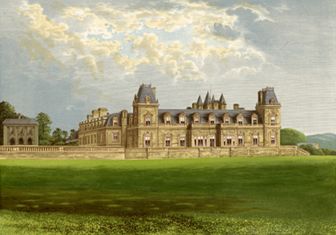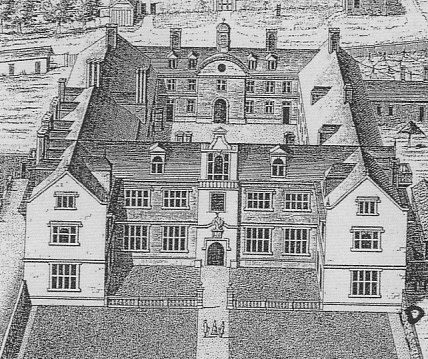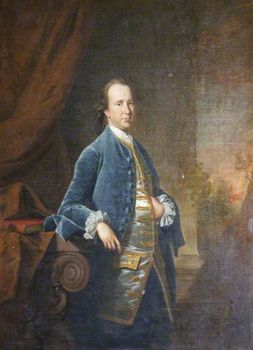|
Richard Stevens (MP)
Richard Stevens (1702–1776) of Winscott in the parish of Peters Marland, Devon, was Member of Parliament for Callington in Cornwall (1761–1768). Origins He was the second son of Richard Stevens (c. 1670 – 1727) of Vielstone in the parish of Buckland Brewer, Devon, (son of Henry Stevens (1617-post 1675) of Vielstone by his wife Judith Hancock (1650–1676), daughter of John Hancock lord of the manor of Combe Martin.) His elder brother was Henry Stevens (1689–1748) of Cross, Little Torrington and Smithacott in the parish of Frithelstock. Ancestry No entry for the Stevens family exists in the 1620 Heraldic Visitation of Devon, and thus the family's pedigree is not officially recorded, and the family must be assumed not to have been counted amongst the gentry of Devon at that time, or to have settled in the county after that date. The earliest record of the Stevens family in Devon is as follows: *William Stevens (died 1648) of Great Torrington. *Henry Stevens ''de Velstone'' ... [...More Info...] [...Related Items...] OR: [Wikipedia] [Google] [Baidu] |
Stevenstone
Stevenstone is a former manor within the parish of St Giles in the Wood, near Great Torrington Great Torrington (often abbreviated to Torrington, though the villages of Little Torrington and Black Torrington are situated in the same region) is a market town in Devon, England. Parts of it are sited on high ground with steep drops down to ..., North Devon. It was the chief seat of the Rolle family, one of the most influential and wealthy of Devon families, from c. 1524 until 1907. The Rolle estates as disclosed by the Return of Owners of Land, 1873 (corrected by Bateman's 'Great Landowners' (1883), Bateman, 1883) comprised 55,592 acres producing an annual gross income of £47,170, and formed the largest estate in Devon, followed by the Francis Russell, 9th Duke of Bedford, Duke of Bedford's estate centred on Tavistock, Devon, Tavistock comprising 22,607 with an annual gross value of nearly £46,000. From the Glorious Revolution of 1688 to the Reform Act of 1832 the coun ... [...More Info...] [...Related Items...] OR: [Wikipedia] [Google] [Baidu] |
Houghton Hall
Houghton Hall ( ) is a country house in the parish of Houghton in Norfolk, England. It is the residence of David Cholmondeley, 7th Marquess of Cholmondeley. It was commissioned by the ''de facto'' first British Prime Minister, Sir Robert Walpole, in 1722, and is a key building in the history of Neo-Palladian architecture in England. It is a Grade I listed building surrounded by of parkland, and is a few miles from Sandringham House. Description The house has a rectangular main block which consists of a rustic basement at ground level, with a ''piano nobile'', bedroom floor and attics above. There are also two lower flanking wings joined to the main block by colonnades. To the south of the house is a detached quadrangular stable block. The exterior is both grand and restrained, constructed of fine-grained, silver-white stone. The Gibbs-designed domes punctuate each corner. In line with Palladian conventions, the interiors are much more colourful, exuberant and opulent than ... [...More Info...] [...Related Items...] OR: [Wikipedia] [Google] [Baidu] |
Prime Minister
A prime minister, premier or chief of cabinet is the head of the cabinet and the leader of the ministers in the executive branch of government, often in a parliamentary or semi-presidential system. Under those systems, a prime minister is not the head of state, but rather the head of government, serving under either a monarch in a democratic constitutional monarchy or under a president in a republican form of government. In parliamentary systems fashioned after the Westminster system, the prime minister is the presiding and actual head of government and head/owner of the executive power. In such systems, the head of state or their official representative (e.g., monarch, president, governor-general) usually holds a largely ceremonial position, although often with reserve powers. Under some presidential systems, such as South Korea and Peru, the prime minister is the leader or most senior member of the cabinet, not the head of government. In many systems, the prime minister ... [...More Info...] [...Related Items...] OR: [Wikipedia] [Google] [Baidu] |
Robert Walpole
Robert Walpole, 1st Earl of Orford, (26 August 1676 – 18 March 1745; known between 1725 and 1742 as Sir Robert Walpole) was a British statesman and Whig politician who, as First Lord of the Treasury, Chancellor of the Exchequer, and Leader of the House of Commons, is generally regarded as the ''de facto'' first Prime Minister of Great Britain. Although the exact dates of Walpole's dominance, dubbed the "Robinocracy", are a matter of scholarly debate, the period 1721–1742 is often used. He dominated the Walpole–Townshend ministry, as well as the subsequent Walpole ministry, and holds the record as the longest-serving British prime minister. W. A. Speck wrote that Walpole's uninterrupted run of 20 years as prime minister "is rightly regarded as one of the major feats of British political history. Explanations are usually offered in terms of his expert handling of the political system after 1720, ndhis unique blending of the surviving powers of the crown with the ... [...More Info...] [...Related Items...] OR: [Wikipedia] [Google] [Baidu] |
Robert Walpole, 2nd Earl Of Orford
Robert Walpole, 2nd Earl of Orford, KB (1701 – 31 March 1751), was a British peer and politician, styled Lord Walpole from 1723 to 1745. Origins He was the eldest son of Sir Robert Walpole (1676–1745), the King's First Minister, now regarded as the first British Prime Minister, by his first wife Catherine Shorter. In 1723 his father declined a peerage for himself but did accept the offer on behalf of his 22-year-old son Robert who was thus raised to the peerage as Baron Walpole, of Walpole in the County of Norfolk. Marriage Circa 26 March 1724 Lord Walpole married the 15-year-old heiress Margaret Rolle (1709–1781), the only surviving daughter of Colonel Samuel Rolle (1646–1719), of Heanton Satchville, Petrockstowe. Margaret was the heiress to a junior branch of the great Rolle family of Stevenstone in Devon and to her paternal grandmother, born Lady Arabella Clinton, an aunt and co-heiress of her nephew Edward Clinton, 5th Earl of Lincoln and 13th Baron Clinton ... [...More Info...] [...Related Items...] OR: [Wikipedia] [Google] [Baidu] |
Margaret Rolle, 15th Baroness Clinton
Margaret Rolle, 15th Baroness Clinton ''suo jure'' (17 January 1709 – 13 January 1781), was a wealthy aristocratic Devonshire heiress, known both for eccentricity and her extramarital affairs. By her first husband Robert, 1st Baron Walpole, later 2nd Earl of Orford (1701–1751) and eldest son of Sir Robert Walpole, she gave birth to a legitimate heir, George Walpole, 3rd Earl of Orford, who succeeded her in the title of Baron Clinton. Family background The only surviving daughter and sole heiress of Samuel Rolle, MP (1646–1719), of Heanton Satchville, Petrockstowe, by his second wife, Margaret, daughter of Roger Tuckfield, of Raddon Court, Devon, a junior branch of the Tuckfield family of Little Fulford, near Crediton, she inherited from her uncle, Roger Tuckfield, MP for the family's pocket borough of Ashburton, following the purchase of the manor of Ashburton in 1702. The Rolle family of Heanton Satchville was a wealthy cadet branch of the Rolles of Stevenstone ... [...More Info...] [...Related Items...] OR: [Wikipedia] [Google] [Baidu] |
Heanton Satchville, Petrockstowe
Heanton Satchville was a historic manor in the parish of Petrockstowe, North Devon, England. With origins in the Domesday manor of Hantone, it was first recorded as belonging to the Yeo family in the mid-14th century and was then owned successively by the Rolle, Walpole and Trefusis families. The mansion house was destroyed by fire in 1795. In 1812 Lord Clinton purchased the manor and mansion of nearby Huish, renamed it Heanton Satchville, and made it his seat. The nearly-forgotten house was featured in the 2005 edition of Rosemary Lauder's "Vanished Houses of North Devon". A farmhouse now occupies the former stable block with a large tractor shed where the house once stood. The political power-base of the Rolle family of Heanton Satchville was the pocket borough seat of Callington in Cornwall, acquired in 1601 when Robert Rolle (died 1633) purchased the manor of Callington.Hunneyball (2010) Description of mansion The mansion was at one time "one of the most imposing house ... [...More Info...] [...Related Items...] OR: [Wikipedia] [Google] [Baidu] |
Buckland Filleigh
Buckland Filleigh is a village, civil parish and former manor in the Torridge district of North Devon, England, situated about 8 miles south of the town of Great Torrington. According to the 2001 census, the parish had a population of 170. It is surrounded clockwise from the north by the parishes of Peters Marland, Petrockstowe, Highampton, Sheepwash and Shebbear. Within the parish is the manor house known as Buckland House, damaged by fire in 1798 and rebuilt in 1810 in the neo-classical style by John Inglett Fortescue (1758–1841) to the designs of the architect James Green. History The manor of Buckland Filleigh is listed in the Domesday Book Domesday Book () – the Middle English spelling of "Doomsday Book" – is a manuscript record of the "Great Survey" of much of England and parts of Wales completed in 1086 by order of King William I, known as William the Conqueror. The manusc ... and was later held successively by the families of de Filleigh, Denzell, Fortes ... [...More Info...] [...Related Items...] OR: [Wikipedia] [Google] [Baidu] |
Baron Clinton
Baron Clinton is a title in the Peerage of England. Created in 1298 for Sir John de Clinton, it is the seventh-oldest barony in England. Creation and early history The title was granted in 1298 to Sir John de Clinton, a knight who had served in the Scottish and French wars. The peerage was created by writ, which means that it can descend through both male and female lines. It is thus one of the most ancient English titles still in existence. William, the younger son of the first Baron, was also summoned to parliament by writ on 6 September 1330 as Baron de Clynton, even though his elder brother, the second Baron, was sitting in parliament under the same title. He was created Earl of Huntingdon in 1337. The second Baron, John, fought with the king's army, which defeated Edward II's cousin Thomas, Earl of Lancaster, at the Battle of Boroughbridge in 1321. He was knighted by 1324. The third Baron fought at the Battle of Poitiers in the Hundred Years' War and was the Constable ... [...More Info...] [...Related Items...] OR: [Wikipedia] [Google] [Baidu] |
Thomas Hudson (painter)
Thomas Hudson (1701–1779) was an English portrait painting, portrait painter. Life Hudson was born in Devon in 1701. His exact birthplace is unknown. He studied under Jonathan Richardson (painter), Jonathan RichardsonJonathon Richardson London - National Portrait Gallery, accessed January 2010 in London and against his wishes, married Richardson's daughter at some point before 1725. Hudson was most prolific between 1740 and 1760 and, from 1745 until 1755 was the most successful London portraitist. He had many assistants, and employed the specialist drapery painter Joseph Van Aken. Joshua Reynolds, Joseph Wright of Derby, Joseph Wright and the drapery painter Peter Toms (painter), Peter Toms were his students. Hudson visited the Low Countries in 1748 ... [...More Info...] [...Related Items...] OR: [Wikipedia] [Google] [Baidu] |
Denys Rolle (died 1797)
Denys Rolle (1725 – 1797) of Hudscott, Beam, Stevenstone and Bicton in Devon and East Tytherley in Hampshire, was an independent Member of Parliament for Barnstaple, Devon, between 1761 and 1774. He inherited a large number of estates and by the time of his death he was the largest landowner in Devon. He was a philanthropist and generous benefactor to charities and religious societies. He spent much of his life in Florida attempting to establish an "ideal society", a Utopian colony of poor, homeless or criminal English persons named Rollestown or Charlotta. The project was a failure and Rolle recorded his colonial adventure in great detail in a lengthy official complaint made in 1765 to the British government entitled ''The Humble Petition of Denys Rolle, Esq., Setting Forth the Hardships, Inconveniences, and Grievances Which Have Attended Him in His Attempts to Make a Settlement in East Florida, Humbly Praying Such Relief as in their Lordships Wisdom Shall Seem Meet''. His ... [...More Info...] [...Related Items...] OR: [Wikipedia] [Google] [Baidu] |







